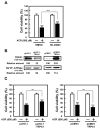Transient Receptor Potential Ankyrin 1 (TRPA1) Channel Mediates Acrolein Cytotoxicity in Human Lung Cancer Cells
- PMID: 37511605
- PMCID: PMC10380761
- DOI: 10.3390/ijms241411847
Transient Receptor Potential Ankyrin 1 (TRPA1) Channel Mediates Acrolein Cytotoxicity in Human Lung Cancer Cells
Abstract
Transient receptor potential ankyrin 1 (TRPA1) is a nonselective ion channel implicated in thermosensation and inflammatory pain. It has been reported that expression of the TRPA1 channel is induced by cigarette smoke extract. Acrolein found in cigarette smoke is highly toxic and known as an agonist of the TRPA1 channel. However, the role of TRPA1 in the cytotoxicity of acrolein remains unclear. Here, we investigated whether the TRPA1 channel is involved in the cytotoxicity of acrolein in human lung cancer A549 cells. The IC50 of acrolein in A549 cells was 25 μM, and acrolein toxicity increased in a concentration- and time-dependent manner. When the effect of acrolein on TRPA1 expression was examined, the expression of TRPA1 in A549 cells was increased by treatment with 50 μM acrolein for 24 h or 500 μM acrolein for 30 min. AP-1, a transcription factor, was activated in the cells treated with 50 μM acrolein for 24 h, while induction of NF-κB and HIF-1α was observed in the cells treated with 500 μM acrolein for 30 min. These results suggest that acrolein induces TRPA1 expression by activating these transcription factors. Overexpression of TRPA1 in A549 cells increased acrolein sensitivity and the level of protein-conjugated acrolein (PC-Acro), while knockdown of TRPA1 in A549 cells or treatment with a TRPA1 antagonist caused tolerance to acrolein. These findings suggest that acrolein induces the TRPA1 channel and that an increase in TRPA1 expression promotes the cytotoxicity of acrolein.
Keywords: acrolein; cell damage; cytotoxicity; transient receptor potential ankyrin 1 (TRPA1).
Conflict of interest statement
The authors declare no conflict of interest.
Figures





References
-
- Story G.M., Peier A.M., Reeve A.J., Eid S.R., Mosbacher J., Hricik T.R., Earley T.J., Hergarden A.C., Andersson D.A., Hwang S.W., et al. ANKTM1, a TRP-like Channel Expressed in Nociceptive Neurons, Is Activated by Cold Temperatures. Cell. 2003;112:819–829. doi: 10.1016/S0092-8674(03)00158-2. - DOI - PubMed
MeSH terms
Substances
Grants and funding
LinkOut - more resources
Full Text Sources
Medical

